case of Australian Supermarkets Assignment
VerifiedAdded on 2021/06/17
|12
|3286
|198
AI Summary
Contribute Materials
Your contribution can guide someone’s learning journey. Share your
documents today.
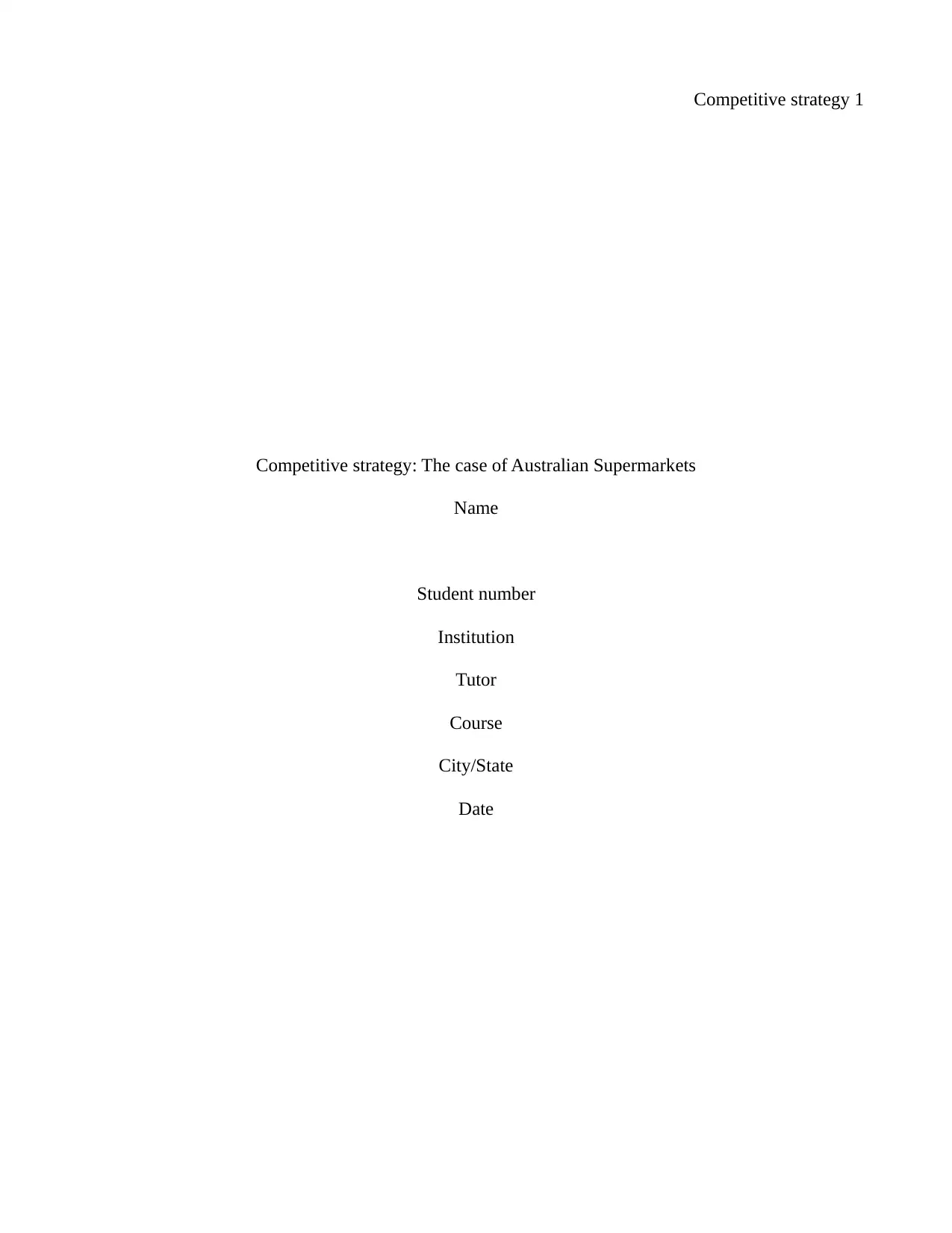
Competitive strategy 1
Competitive strategy: The case of Australian Supermarkets
Name
Student number
Institution
Tutor
Course
City/State
Date
Competitive strategy: The case of Australian Supermarkets
Name
Student number
Institution
Tutor
Course
City/State
Date
Secure Best Marks with AI Grader
Need help grading? Try our AI Grader for instant feedback on your assignments.
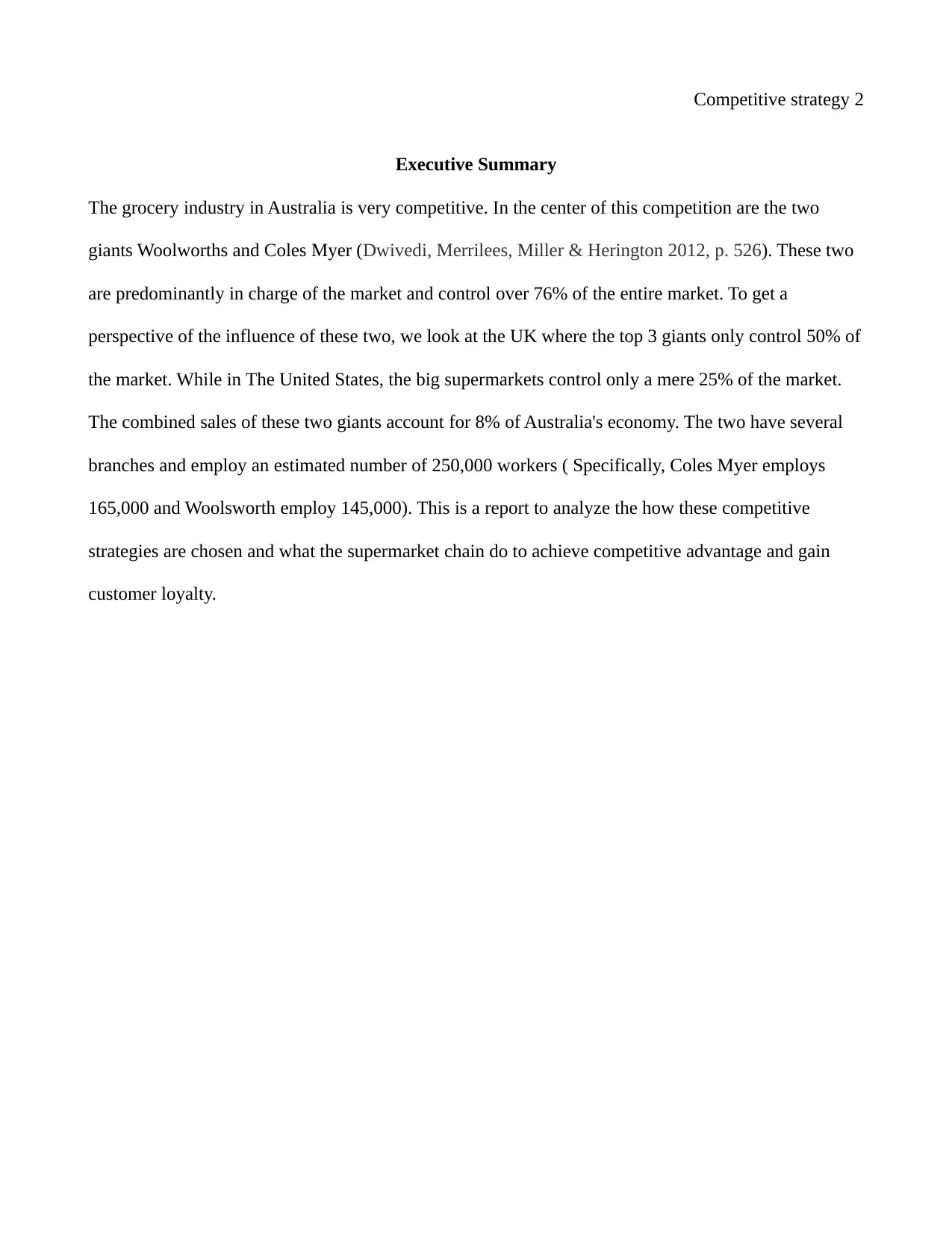
Competitive strategy 2
Executive Summary
The grocery industry in Australia is very competitive. In the center of this competition are the two
giants Woolworths and Coles Myer (Dwivedi, Merrilees, Miller & Herington 2012, p. 526). These two
are predominantly in charge of the market and control over 76% of the entire market. To get a
perspective of the influence of these two, we look at the UK where the top 3 giants only control 50% of
the market. While in The United States, the big supermarkets control only a mere 25% of the market.
The combined sales of these two giants account for 8% of Australia's economy. The two have several
branches and employ an estimated number of 250,000 workers ( Specifically, Coles Myer employs
165,000 and Woolsworth employ 145,000). This is a report to analyze the how these competitive
strategies are chosen and what the supermarket chain do to achieve competitive advantage and gain
customer loyalty.
Executive Summary
The grocery industry in Australia is very competitive. In the center of this competition are the two
giants Woolworths and Coles Myer (Dwivedi, Merrilees, Miller & Herington 2012, p. 526). These two
are predominantly in charge of the market and control over 76% of the entire market. To get a
perspective of the influence of these two, we look at the UK where the top 3 giants only control 50% of
the market. While in The United States, the big supermarkets control only a mere 25% of the market.
The combined sales of these two giants account for 8% of Australia's economy. The two have several
branches and employ an estimated number of 250,000 workers ( Specifically, Coles Myer employs
165,000 and Woolsworth employ 145,000). This is a report to analyze the how these competitive
strategies are chosen and what the supermarket chain do to achieve competitive advantage and gain
customer loyalty.

Competitive strategy 3
Introduction
The Australian Supermarkets have made the grocery industry in Australia the most competitive in the
world. In the centre of this competition are the two giants Woolworths and Coles Myer. These two are
predominantly in charge of the market and control over 76% of the entire market. To get a perspective
of the influence of these two, we look at the UK where the top 3 giants only control 50% of the market.
While in The United States, the big supermarkets control only a mere 25% of the market (James 2016,
p. 103). The combined sales of these two giants account for 8% of Australia's economy. The two have
several branches and employ an estimated number of 250,000 workers.
But despite their undisputed control of the market, there still exists bitter rivalry between the two
companies. With the introduction, other giants like Aldi and Costco, the annual revenue is projected to
increase to 91.6 billion dollars for 50 billion dollars (Gallacher 2011, p. 147). This is projected to
happen in less than five years.
The situation for the two already established giants is only getting worse. The introduction of ALDI
and the announcement that Lidl will also target the Australian market has threatened the duopoly
created by these two giants (Low 2015, p. 5). When ALDI opened in 2001, Woolworth and Coles
attempted to fight back the competition by implementing a cost-reduction method. But the invasion of
other giants is going to affect the duopoly as well as shrink the market share capital for other smaller
chains or independent retailers (Sutton-Brady, Taylor & Kamvounias 2017, p. 1051).
The most accurate data on the grocery industry in Australia is gotten from looking the industry
dynamics from each state.
This report aims to look at the business strategies applied by some of the giants as well the competitive
strategies and the competitive dynamics used to gain an advantage over the competition. How these
companies strive to keep up their aggressive expansion amidst intense competition from already
Introduction
The Australian Supermarkets have made the grocery industry in Australia the most competitive in the
world. In the centre of this competition are the two giants Woolworths and Coles Myer. These two are
predominantly in charge of the market and control over 76% of the entire market. To get a perspective
of the influence of these two, we look at the UK where the top 3 giants only control 50% of the market.
While in The United States, the big supermarkets control only a mere 25% of the market (James 2016,
p. 103). The combined sales of these two giants account for 8% of Australia's economy. The two have
several branches and employ an estimated number of 250,000 workers.
But despite their undisputed control of the market, there still exists bitter rivalry between the two
companies. With the introduction, other giants like Aldi and Costco, the annual revenue is projected to
increase to 91.6 billion dollars for 50 billion dollars (Gallacher 2011, p. 147). This is projected to
happen in less than five years.
The situation for the two already established giants is only getting worse. The introduction of ALDI
and the announcement that Lidl will also target the Australian market has threatened the duopoly
created by these two giants (Low 2015, p. 5). When ALDI opened in 2001, Woolworth and Coles
attempted to fight back the competition by implementing a cost-reduction method. But the invasion of
other giants is going to affect the duopoly as well as shrink the market share capital for other smaller
chains or independent retailers (Sutton-Brady, Taylor & Kamvounias 2017, p. 1051).
The most accurate data on the grocery industry in Australia is gotten from looking the industry
dynamics from each state.
This report aims to look at the business strategies applied by some of the giants as well the competitive
strategies and the competitive dynamics used to gain an advantage over the competition. How these
companies strive to keep up their aggressive expansion amidst intense competition from already
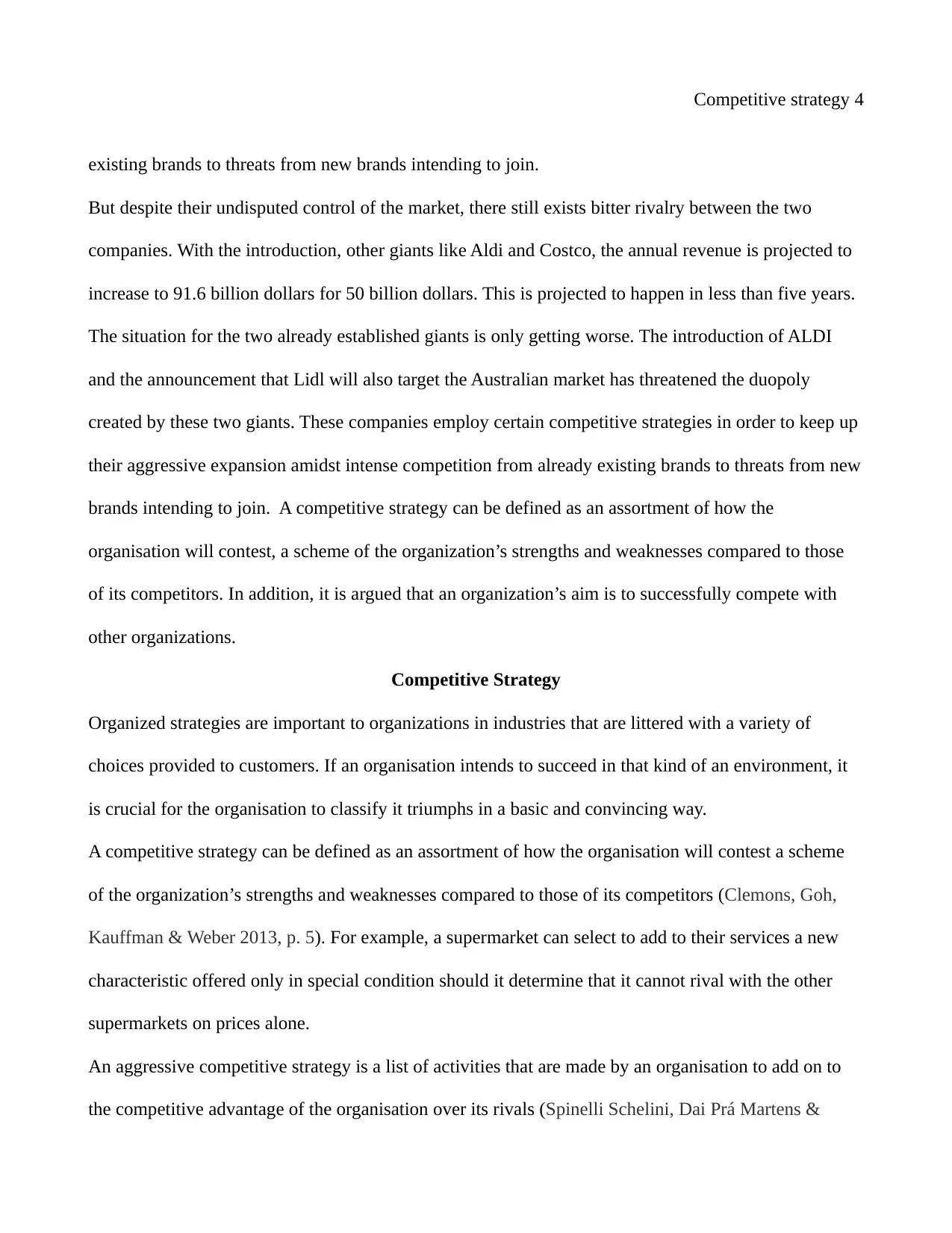
Competitive strategy 4
existing brands to threats from new brands intending to join.
But despite their undisputed control of the market, there still exists bitter rivalry between the two
companies. With the introduction, other giants like Aldi and Costco, the annual revenue is projected to
increase to 91.6 billion dollars for 50 billion dollars. This is projected to happen in less than five years.
The situation for the two already established giants is only getting worse. The introduction of ALDI
and the announcement that Lidl will also target the Australian market has threatened the duopoly
created by these two giants. These companies employ certain competitive strategies in order to keep up
their aggressive expansion amidst intense competition from already existing brands to threats from new
brands intending to join. A competitive strategy can be defined as an assortment of how the
organisation will contest, a scheme of the organization’s strengths and weaknesses compared to those
of its competitors. In addition, it is argued that an organization’s aim is to successfully compete with
other organizations.
Competitive Strategy
Organized strategies are important to organizations in industries that are littered with a variety of
choices provided to customers. If an organisation intends to succeed in that kind of an environment, it
is crucial for the organisation to classify it triumphs in a basic and convincing way.
A competitive strategy can be defined as an assortment of how the organisation will contest a scheme
of the organization’s strengths and weaknesses compared to those of its competitors (Clemons, Goh,
Kauffman & Weber 2013, p. 5). For example, a supermarket can select to add to their services a new
characteristic offered only in special condition should it determine that it cannot rival with the other
supermarkets on prices alone.
An aggressive competitive strategy is a list of activities that are made by an organisation to add on to
the competitive advantage of the organisation over its rivals (Spinelli Schelini, Dai Prá Martens &
existing brands to threats from new brands intending to join.
But despite their undisputed control of the market, there still exists bitter rivalry between the two
companies. With the introduction, other giants like Aldi and Costco, the annual revenue is projected to
increase to 91.6 billion dollars for 50 billion dollars. This is projected to happen in less than five years.
The situation for the two already established giants is only getting worse. The introduction of ALDI
and the announcement that Lidl will also target the Australian market has threatened the duopoly
created by these two giants. These companies employ certain competitive strategies in order to keep up
their aggressive expansion amidst intense competition from already existing brands to threats from new
brands intending to join. A competitive strategy can be defined as an assortment of how the
organisation will contest, a scheme of the organization’s strengths and weaknesses compared to those
of its competitors. In addition, it is argued that an organization’s aim is to successfully compete with
other organizations.
Competitive Strategy
Organized strategies are important to organizations in industries that are littered with a variety of
choices provided to customers. If an organisation intends to succeed in that kind of an environment, it
is crucial for the organisation to classify it triumphs in a basic and convincing way.
A competitive strategy can be defined as an assortment of how the organisation will contest a scheme
of the organization’s strengths and weaknesses compared to those of its competitors (Clemons, Goh,
Kauffman & Weber 2013, p. 5). For example, a supermarket can select to add to their services a new
characteristic offered only in special condition should it determine that it cannot rival with the other
supermarkets on prices alone.
An aggressive competitive strategy is a list of activities that are made by an organisation to add on to
the competitive advantage of the organisation over its rivals (Spinelli Schelini, Dai Prá Martens &
Secure Best Marks with AI Grader
Need help grading? Try our AI Grader for instant feedback on your assignments.
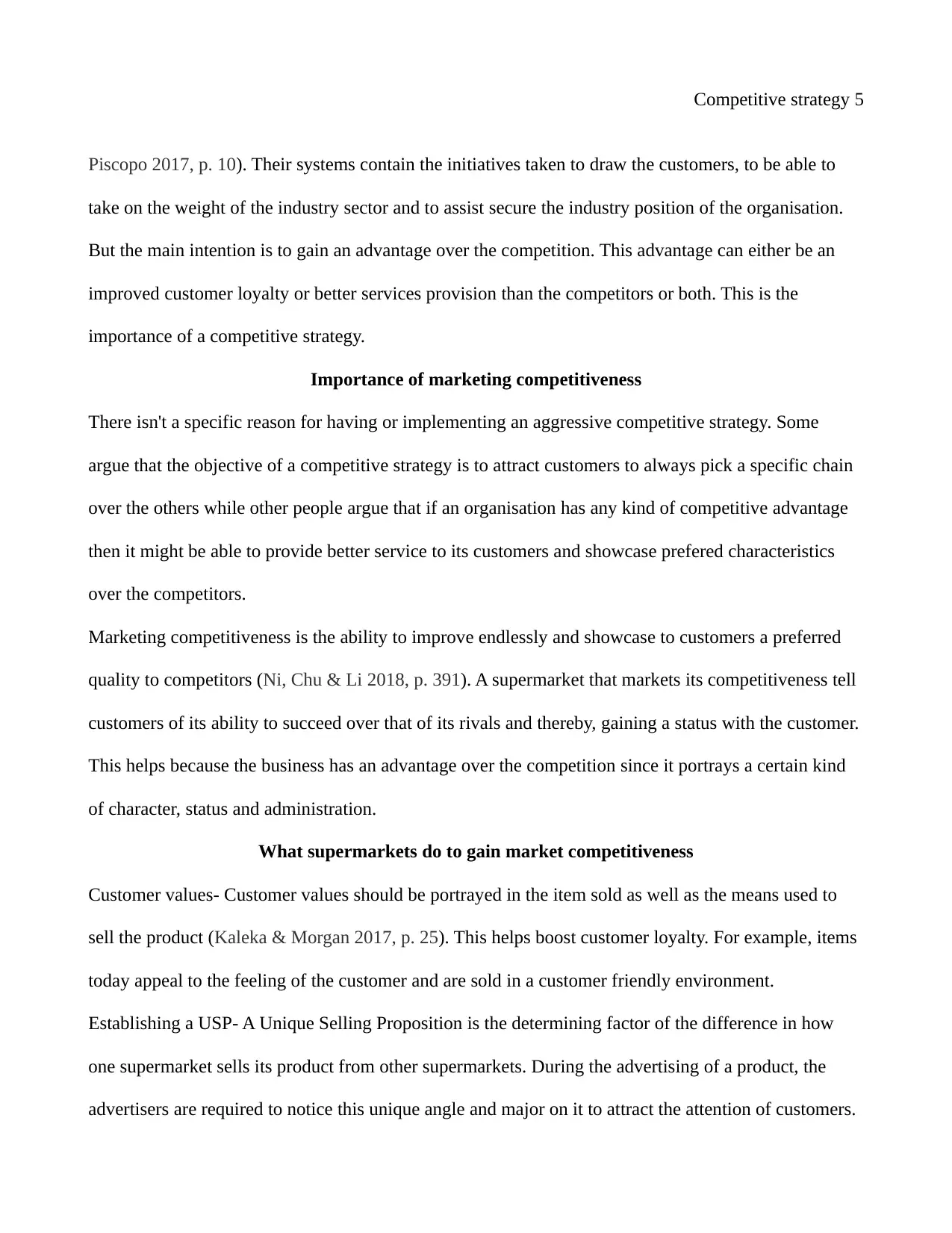
Competitive strategy 5
Piscopo 2017, p. 10). Their systems contain the initiatives taken to draw the customers, to be able to
take on the weight of the industry sector and to assist secure the industry position of the organisation.
But the main intention is to gain an advantage over the competition. This advantage can either be an
improved customer loyalty or better services provision than the competitors or both. This is the
importance of a competitive strategy.
Importance of marketing competitiveness
There isn't a specific reason for having or implementing an aggressive competitive strategy. Some
argue that the objective of a competitive strategy is to attract customers to always pick a specific chain
over the others while other people argue that if an organisation has any kind of competitive advantage
then it might be able to provide better service to its customers and showcase prefered characteristics
over the competitors.
Marketing competitiveness is the ability to improve endlessly and showcase to customers a preferred
quality to competitors (Ni, Chu & Li 2018, p. 391). A supermarket that markets its competitiveness tell
customers of its ability to succeed over that of its rivals and thereby, gaining a status with the customer.
This helps because the business has an advantage over the competition since it portrays a certain kind
of character, status and administration.
What supermarkets do to gain market competitiveness
Customer values- Customer values should be portrayed in the item sold as well as the means used to
sell the product (Kaleka & Morgan 2017, p. 25). This helps boost customer loyalty. For example, items
today appeal to the feeling of the customer and are sold in a customer friendly environment.
Establishing a USP- A Unique Selling Proposition is the determining factor of the difference in how
one supermarket sells its product from other supermarkets. During the advertising of a product, the
advertisers are required to notice this unique angle and major on it to attract the attention of customers.
Piscopo 2017, p. 10). Their systems contain the initiatives taken to draw the customers, to be able to
take on the weight of the industry sector and to assist secure the industry position of the organisation.
But the main intention is to gain an advantage over the competition. This advantage can either be an
improved customer loyalty or better services provision than the competitors or both. This is the
importance of a competitive strategy.
Importance of marketing competitiveness
There isn't a specific reason for having or implementing an aggressive competitive strategy. Some
argue that the objective of a competitive strategy is to attract customers to always pick a specific chain
over the others while other people argue that if an organisation has any kind of competitive advantage
then it might be able to provide better service to its customers and showcase prefered characteristics
over the competitors.
Marketing competitiveness is the ability to improve endlessly and showcase to customers a preferred
quality to competitors (Ni, Chu & Li 2018, p. 391). A supermarket that markets its competitiveness tell
customers of its ability to succeed over that of its rivals and thereby, gaining a status with the customer.
This helps because the business has an advantage over the competition since it portrays a certain kind
of character, status and administration.
What supermarkets do to gain market competitiveness
Customer values- Customer values should be portrayed in the item sold as well as the means used to
sell the product (Kaleka & Morgan 2017, p. 25). This helps boost customer loyalty. For example, items
today appeal to the feeling of the customer and are sold in a customer friendly environment.
Establishing a USP- A Unique Selling Proposition is the determining factor of the difference in how
one supermarket sells its product from other supermarkets. During the advertising of a product, the
advertisers are required to notice this unique angle and major on it to attract the attention of customers.
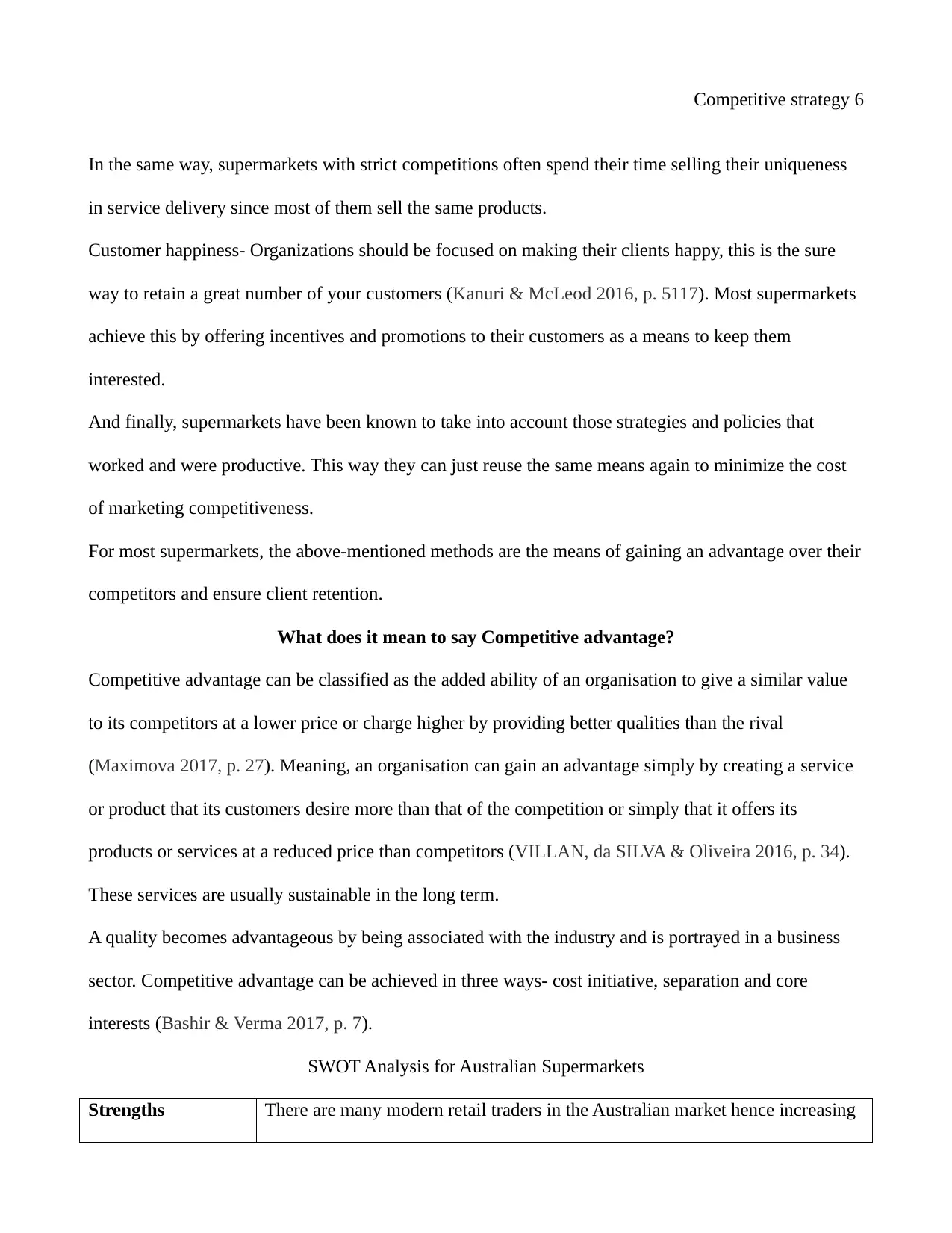
Competitive strategy 6
In the same way, supermarkets with strict competitions often spend their time selling their uniqueness
in service delivery since most of them sell the same products.
Customer happiness- Organizations should be focused on making their clients happy, this is the sure
way to retain a great number of your customers (Kanuri & McLeod 2016, p. 5117). Most supermarkets
achieve this by offering incentives and promotions to their customers as a means to keep them
interested.
And finally, supermarkets have been known to take into account those strategies and policies that
worked and were productive. This way they can just reuse the same means again to minimize the cost
of marketing competitiveness.
For most supermarkets, the above-mentioned methods are the means of gaining an advantage over their
competitors and ensure client retention.
What does it mean to say Competitive advantage?
Competitive advantage can be classified as the added ability of an organisation to give a similar value
to its competitors at a lower price or charge higher by providing better qualities than the rival
(Maximova 2017, p. 27). Meaning, an organisation can gain an advantage simply by creating a service
or product that its customers desire more than that of the competition or simply that it offers its
products or services at a reduced price than competitors (VILLAN, da SILVA & Oliveira 2016, p. 34).
These services are usually sustainable in the long term.
A quality becomes advantageous by being associated with the industry and is portrayed in a business
sector. Competitive advantage can be achieved in three ways- cost initiative, separation and core
interests (Bashir & Verma 2017, p. 7).
SWOT Analysis for Australian Supermarkets
Strengths There are many modern retail traders in the Australian market hence increasing
In the same way, supermarkets with strict competitions often spend their time selling their uniqueness
in service delivery since most of them sell the same products.
Customer happiness- Organizations should be focused on making their clients happy, this is the sure
way to retain a great number of your customers (Kanuri & McLeod 2016, p. 5117). Most supermarkets
achieve this by offering incentives and promotions to their customers as a means to keep them
interested.
And finally, supermarkets have been known to take into account those strategies and policies that
worked and were productive. This way they can just reuse the same means again to minimize the cost
of marketing competitiveness.
For most supermarkets, the above-mentioned methods are the means of gaining an advantage over their
competitors and ensure client retention.
What does it mean to say Competitive advantage?
Competitive advantage can be classified as the added ability of an organisation to give a similar value
to its competitors at a lower price or charge higher by providing better qualities than the rival
(Maximova 2017, p. 27). Meaning, an organisation can gain an advantage simply by creating a service
or product that its customers desire more than that of the competition or simply that it offers its
products or services at a reduced price than competitors (VILLAN, da SILVA & Oliveira 2016, p. 34).
These services are usually sustainable in the long term.
A quality becomes advantageous by being associated with the industry and is portrayed in a business
sector. Competitive advantage can be achieved in three ways- cost initiative, separation and core
interests (Bashir & Verma 2017, p. 7).
SWOT Analysis for Australian Supermarkets
Strengths There are many modern retail traders in the Australian market hence increasing
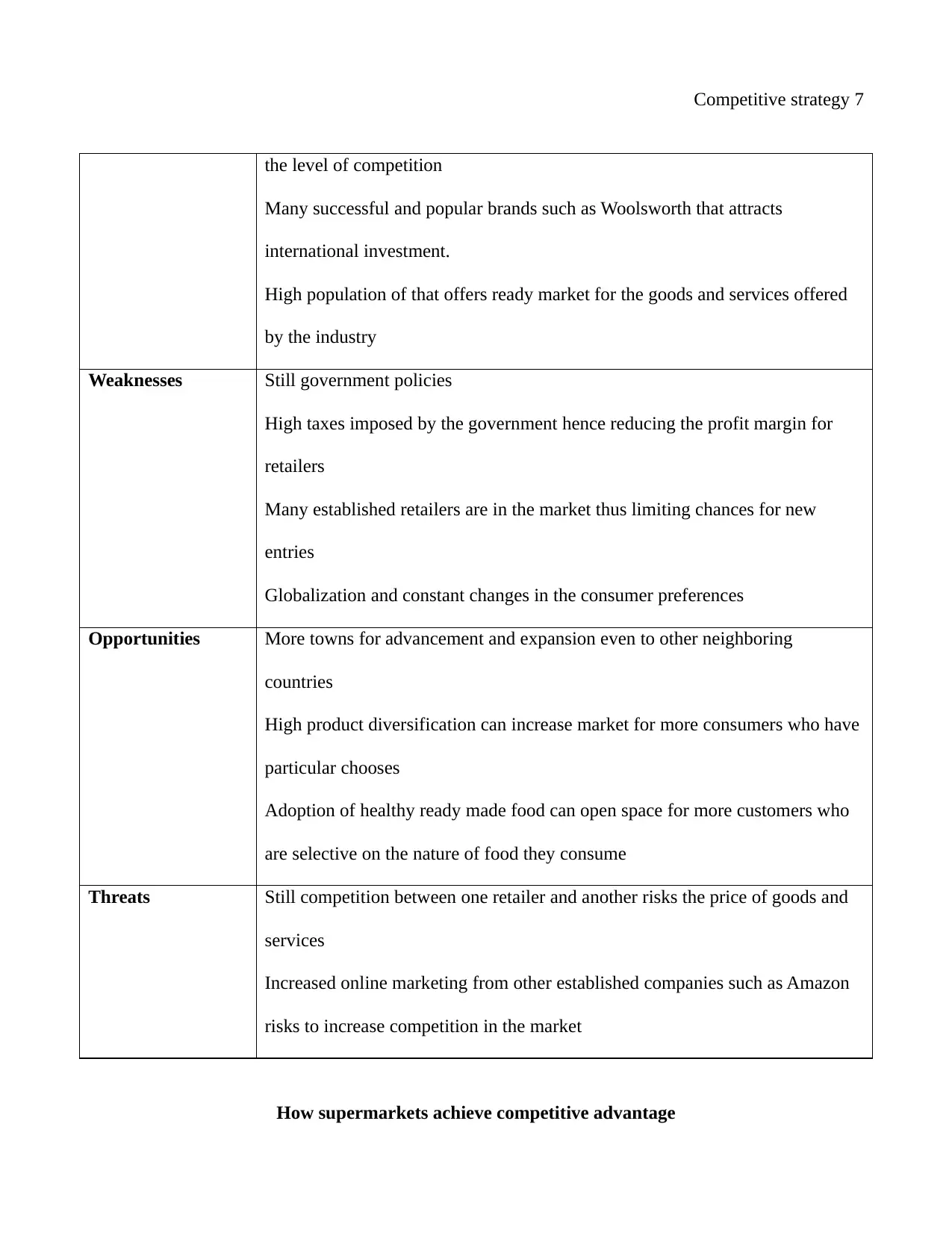
Competitive strategy 7
the level of competition
Many successful and popular brands such as Woolsworth that attracts
international investment.
High population of that offers ready market for the goods and services offered
by the industry
Weaknesses Still government policies
High taxes imposed by the government hence reducing the profit margin for
retailers
Many established retailers are in the market thus limiting chances for new
entries
Globalization and constant changes in the consumer preferences
Opportunities More towns for advancement and expansion even to other neighboring
countries
High product diversification can increase market for more consumers who have
particular chooses
Adoption of healthy ready made food can open space for more customers who
are selective on the nature of food they consume
Threats Still competition between one retailer and another risks the price of goods and
services
Increased online marketing from other established companies such as Amazon
risks to increase competition in the market
How supermarkets achieve competitive advantage
the level of competition
Many successful and popular brands such as Woolsworth that attracts
international investment.
High population of that offers ready market for the goods and services offered
by the industry
Weaknesses Still government policies
High taxes imposed by the government hence reducing the profit margin for
retailers
Many established retailers are in the market thus limiting chances for new
entries
Globalization and constant changes in the consumer preferences
Opportunities More towns for advancement and expansion even to other neighboring
countries
High product diversification can increase market for more consumers who have
particular chooses
Adoption of healthy ready made food can open space for more customers who
are selective on the nature of food they consume
Threats Still competition between one retailer and another risks the price of goods and
services
Increased online marketing from other established companies such as Amazon
risks to increase competition in the market
How supermarkets achieve competitive advantage
Paraphrase This Document
Need a fresh take? Get an instant paraphrase of this document with our AI Paraphraser
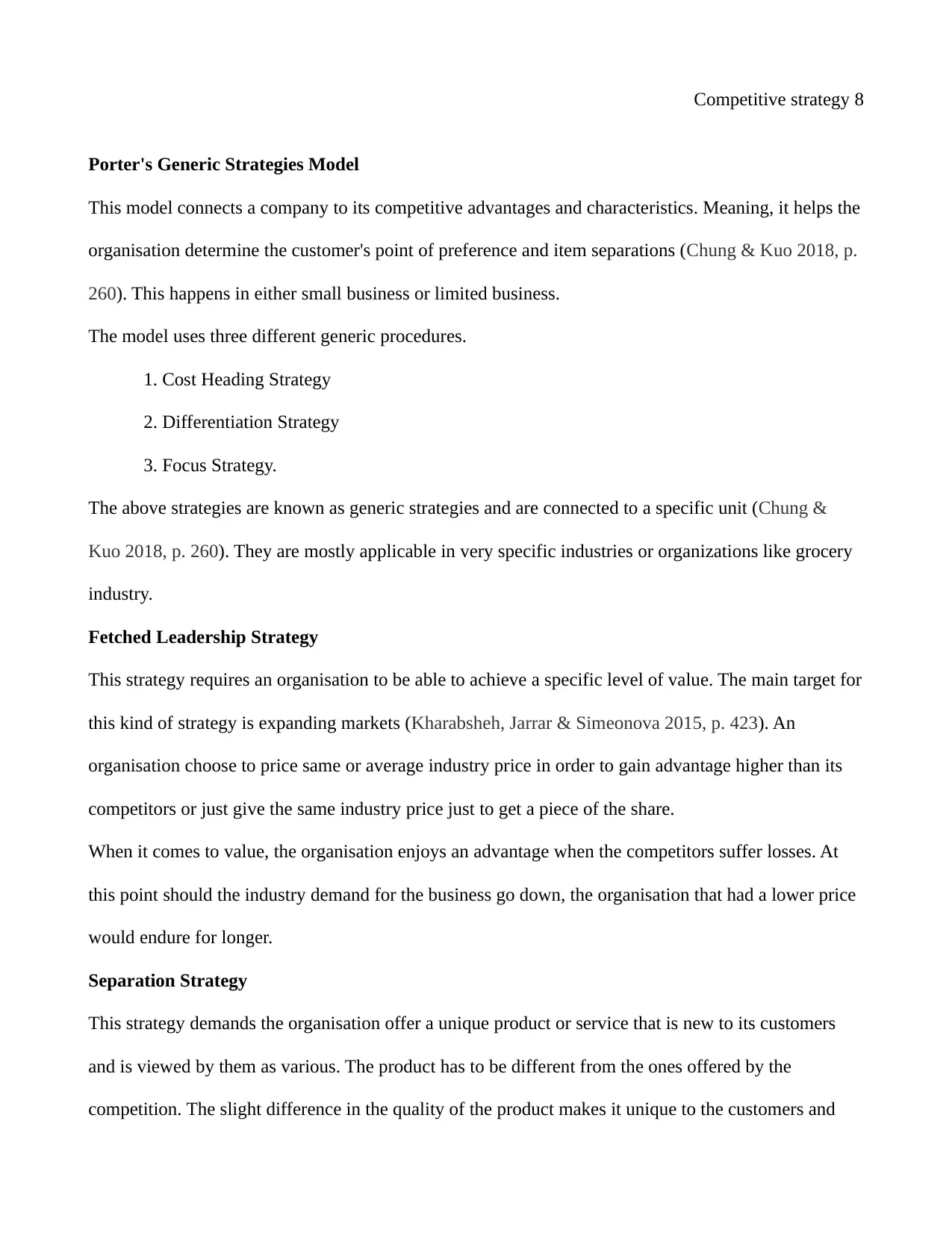
Competitive strategy 8
Porter's Generic Strategies Model
This model connects a company to its competitive advantages and characteristics. Meaning, it helps the
organisation determine the customer's point of preference and item separations (Chung & Kuo 2018, p.
260). This happens in either small business or limited business.
The model uses three different generic procedures.
1. Cost Heading Strategy
2. Differentiation Strategy
3. Focus Strategy.
The above strategies are known as generic strategies and are connected to a specific unit (Chung &
Kuo 2018, p. 260). They are mostly applicable in very specific industries or organizations like grocery
industry.
Fetched Leadership Strategy
This strategy requires an organisation to be able to achieve a specific level of value. The main target for
this kind of strategy is expanding markets (Kharabsheh, Jarrar & Simeonova 2015, p. 423). An
organisation choose to price same or average industry price in order to gain advantage higher than its
competitors or just give the same industry price just to get a piece of the share.
When it comes to value, the organisation enjoys an advantage when the competitors suffer losses. At
this point should the industry demand for the business go down, the organisation that had a lower price
would endure for longer.
Separation Strategy
This strategy demands the organisation offer a unique product or service that is new to its customers
and is viewed by them as various. The product has to be different from the ones offered by the
competition. The slight difference in the quality of the product makes it unique to the customers and
Porter's Generic Strategies Model
This model connects a company to its competitive advantages and characteristics. Meaning, it helps the
organisation determine the customer's point of preference and item separations (Chung & Kuo 2018, p.
260). This happens in either small business or limited business.
The model uses three different generic procedures.
1. Cost Heading Strategy
2. Differentiation Strategy
3. Focus Strategy.
The above strategies are known as generic strategies and are connected to a specific unit (Chung &
Kuo 2018, p. 260). They are mostly applicable in very specific industries or organizations like grocery
industry.
Fetched Leadership Strategy
This strategy requires an organisation to be able to achieve a specific level of value. The main target for
this kind of strategy is expanding markets (Kharabsheh, Jarrar & Simeonova 2015, p. 423). An
organisation choose to price same or average industry price in order to gain advantage higher than its
competitors or just give the same industry price just to get a piece of the share.
When it comes to value, the organisation enjoys an advantage when the competitors suffer losses. At
this point should the industry demand for the business go down, the organisation that had a lower price
would endure for longer.
Separation Strategy
This strategy demands the organisation offer a unique product or service that is new to its customers
and is viewed by them as various. The product has to be different from the ones offered by the
competition. The slight difference in the quality of the product makes it unique to the customers and
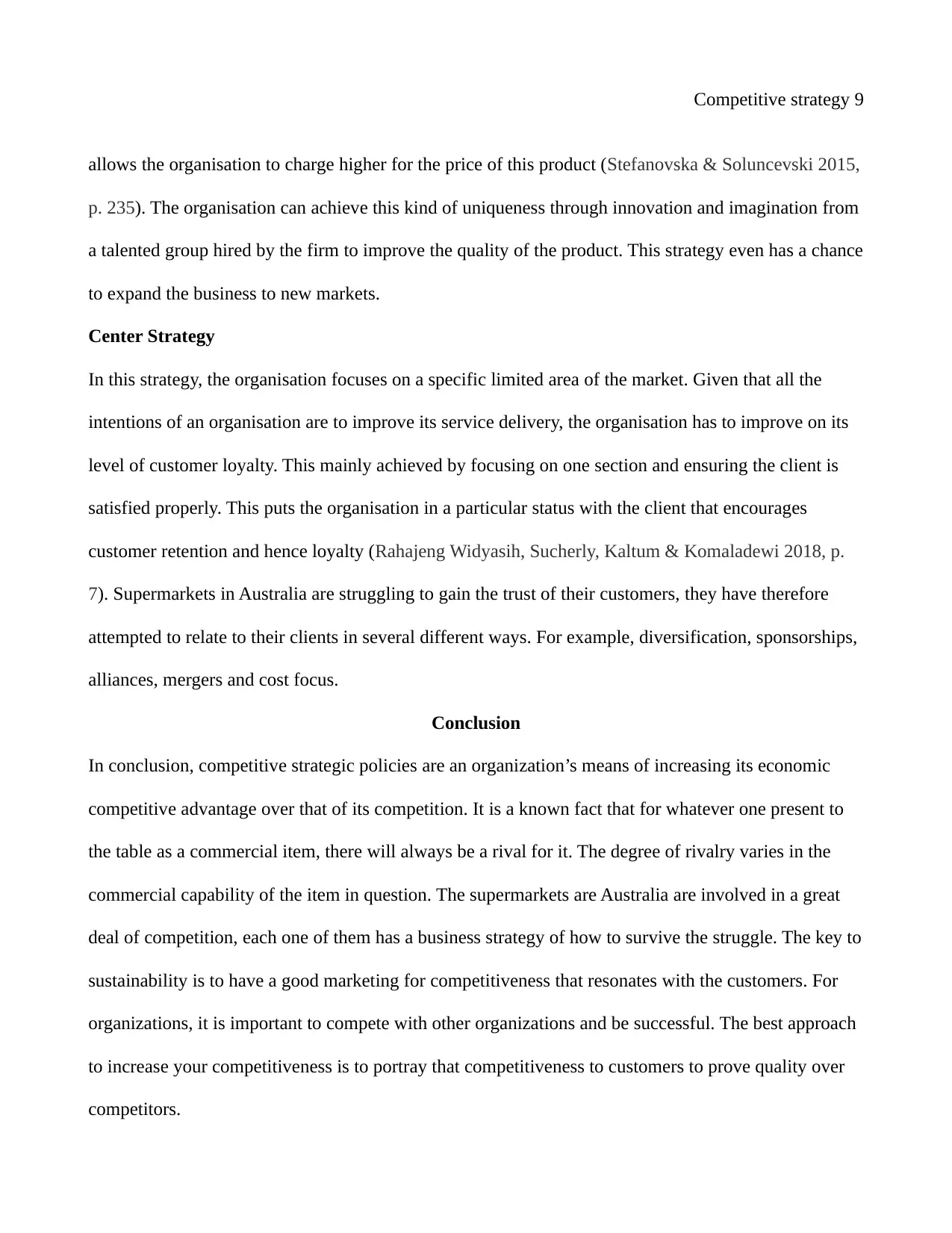
Competitive strategy 9
allows the organisation to charge higher for the price of this product (Stefanovska & Soluncevski 2015,
p. 235). The organisation can achieve this kind of uniqueness through innovation and imagination from
a talented group hired by the firm to improve the quality of the product. This strategy even has a chance
to expand the business to new markets.
Center Strategy
In this strategy, the organisation focuses on a specific limited area of the market. Given that all the
intentions of an organisation are to improve its service delivery, the organisation has to improve on its
level of customer loyalty. This mainly achieved by focusing on one section and ensuring the client is
satisfied properly. This puts the organisation in a particular status with the client that encourages
customer retention and hence loyalty (Rahajeng Widyasih, Sucherly, Kaltum & Komaladewi 2018, p.
7). Supermarkets in Australia are struggling to gain the trust of their customers, they have therefore
attempted to relate to their clients in several different ways. For example, diversification, sponsorships,
alliances, mergers and cost focus.
Conclusion
In conclusion, competitive strategic policies are an organization’s means of increasing its economic
competitive advantage over that of its competition. It is a known fact that for whatever one present to
the table as a commercial item, there will always be a rival for it. The degree of rivalry varies in the
commercial capability of the item in question. The supermarkets are Australia are involved in a great
deal of competition, each one of them has a business strategy of how to survive the struggle. The key to
sustainability is to have a good marketing for competitiveness that resonates with the customers. For
organizations, it is important to compete with other organizations and be successful. The best approach
to increase your competitiveness is to portray that competitiveness to customers to prove quality over
competitors.
allows the organisation to charge higher for the price of this product (Stefanovska & Soluncevski 2015,
p. 235). The organisation can achieve this kind of uniqueness through innovation and imagination from
a talented group hired by the firm to improve the quality of the product. This strategy even has a chance
to expand the business to new markets.
Center Strategy
In this strategy, the organisation focuses on a specific limited area of the market. Given that all the
intentions of an organisation are to improve its service delivery, the organisation has to improve on its
level of customer loyalty. This mainly achieved by focusing on one section and ensuring the client is
satisfied properly. This puts the organisation in a particular status with the client that encourages
customer retention and hence loyalty (Rahajeng Widyasih, Sucherly, Kaltum & Komaladewi 2018, p.
7). Supermarkets in Australia are struggling to gain the trust of their customers, they have therefore
attempted to relate to their clients in several different ways. For example, diversification, sponsorships,
alliances, mergers and cost focus.
Conclusion
In conclusion, competitive strategic policies are an organization’s means of increasing its economic
competitive advantage over that of its competition. It is a known fact that for whatever one present to
the table as a commercial item, there will always be a rival for it. The degree of rivalry varies in the
commercial capability of the item in question. The supermarkets are Australia are involved in a great
deal of competition, each one of them has a business strategy of how to survive the struggle. The key to
sustainability is to have a good marketing for competitiveness that resonates with the customers. For
organizations, it is important to compete with other organizations and be successful. The best approach
to increase your competitiveness is to portray that competitiveness to customers to prove quality over
competitors.
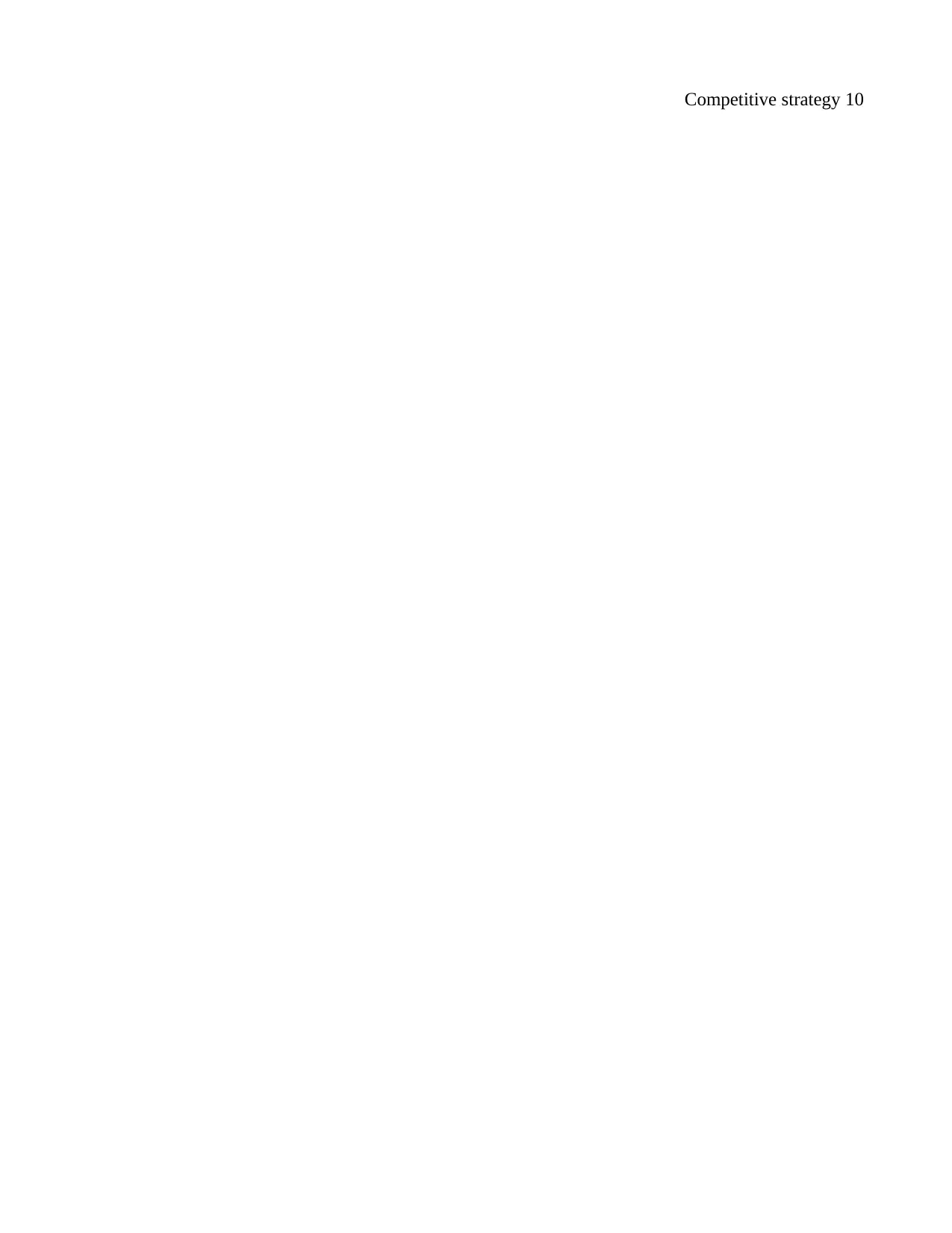
Competitive strategy 10
Secure Best Marks with AI Grader
Need help grading? Try our AI Grader for instant feedback on your assignments.
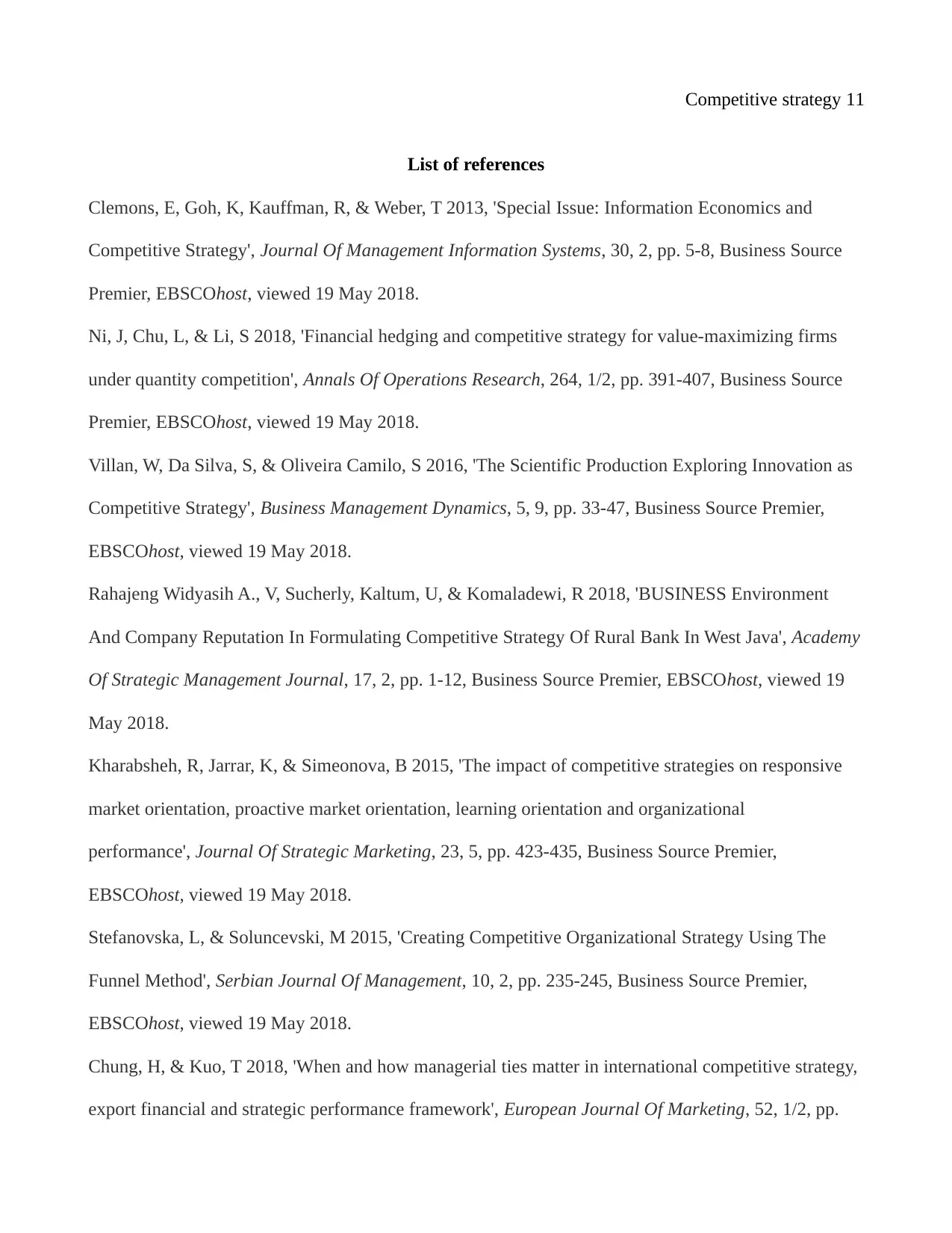
Competitive strategy 11
List of references
Clemons, E, Goh, K, Kauffman, R, & Weber, T 2013, 'Special Issue: Information Economics and
Competitive Strategy', Journal Of Management Information Systems, 30, 2, pp. 5-8, Business Source
Premier, EBSCOhost, viewed 19 May 2018.
Ni, J, Chu, L, & Li, S 2018, 'Financial hedging and competitive strategy for value-maximizing firms
under quantity competition', Annals Of Operations Research, 264, 1/2, pp. 391-407, Business Source
Premier, EBSCOhost, viewed 19 May 2018.
Villan, W, Da Silva, S, & Oliveira Camilo, S 2016, 'The Scientific Production Exploring Innovation as
Competitive Strategy', Business Management Dynamics, 5, 9, pp. 33-47, Business Source Premier,
EBSCOhost, viewed 19 May 2018.
Rahajeng Widyasih A., V, Sucherly, Kaltum, U, & Komaladewi, R 2018, 'BUSINESS Environment
And Company Reputation In Formulating Competitive Strategy Of Rural Bank In West Java', Academy
Of Strategic Management Journal, 17, 2, pp. 1-12, Business Source Premier, EBSCOhost, viewed 19
May 2018.
Kharabsheh, R, Jarrar, K, & Simeonova, B 2015, 'The impact of competitive strategies on responsive
market orientation, proactive market orientation, learning orientation and organizational
performance', Journal Of Strategic Marketing, 23, 5, pp. 423-435, Business Source Premier,
EBSCOhost, viewed 19 May 2018.
Stefanovska, L, & Soluncevski, M 2015, 'Creating Competitive Organizational Strategy Using The
Funnel Method', Serbian Journal Of Management, 10, 2, pp. 235-245, Business Source Premier,
EBSCOhost, viewed 19 May 2018.
Chung, H, & Kuo, T 2018, 'When and how managerial ties matter in international competitive strategy,
export financial and strategic performance framework', European Journal Of Marketing, 52, 1/2, pp.
List of references
Clemons, E, Goh, K, Kauffman, R, & Weber, T 2013, 'Special Issue: Information Economics and
Competitive Strategy', Journal Of Management Information Systems, 30, 2, pp. 5-8, Business Source
Premier, EBSCOhost, viewed 19 May 2018.
Ni, J, Chu, L, & Li, S 2018, 'Financial hedging and competitive strategy for value-maximizing firms
under quantity competition', Annals Of Operations Research, 264, 1/2, pp. 391-407, Business Source
Premier, EBSCOhost, viewed 19 May 2018.
Villan, W, Da Silva, S, & Oliveira Camilo, S 2016, 'The Scientific Production Exploring Innovation as
Competitive Strategy', Business Management Dynamics, 5, 9, pp. 33-47, Business Source Premier,
EBSCOhost, viewed 19 May 2018.
Rahajeng Widyasih A., V, Sucherly, Kaltum, U, & Komaladewi, R 2018, 'BUSINESS Environment
And Company Reputation In Formulating Competitive Strategy Of Rural Bank In West Java', Academy
Of Strategic Management Journal, 17, 2, pp. 1-12, Business Source Premier, EBSCOhost, viewed 19
May 2018.
Kharabsheh, R, Jarrar, K, & Simeonova, B 2015, 'The impact of competitive strategies on responsive
market orientation, proactive market orientation, learning orientation and organizational
performance', Journal Of Strategic Marketing, 23, 5, pp. 423-435, Business Source Premier,
EBSCOhost, viewed 19 May 2018.
Stefanovska, L, & Soluncevski, M 2015, 'Creating Competitive Organizational Strategy Using The
Funnel Method', Serbian Journal Of Management, 10, 2, pp. 235-245, Business Source Premier,
EBSCOhost, viewed 19 May 2018.
Chung, H, & Kuo, T 2018, 'When and how managerial ties matter in international competitive strategy,
export financial and strategic performance framework', European Journal Of Marketing, 52, 1/2, pp.
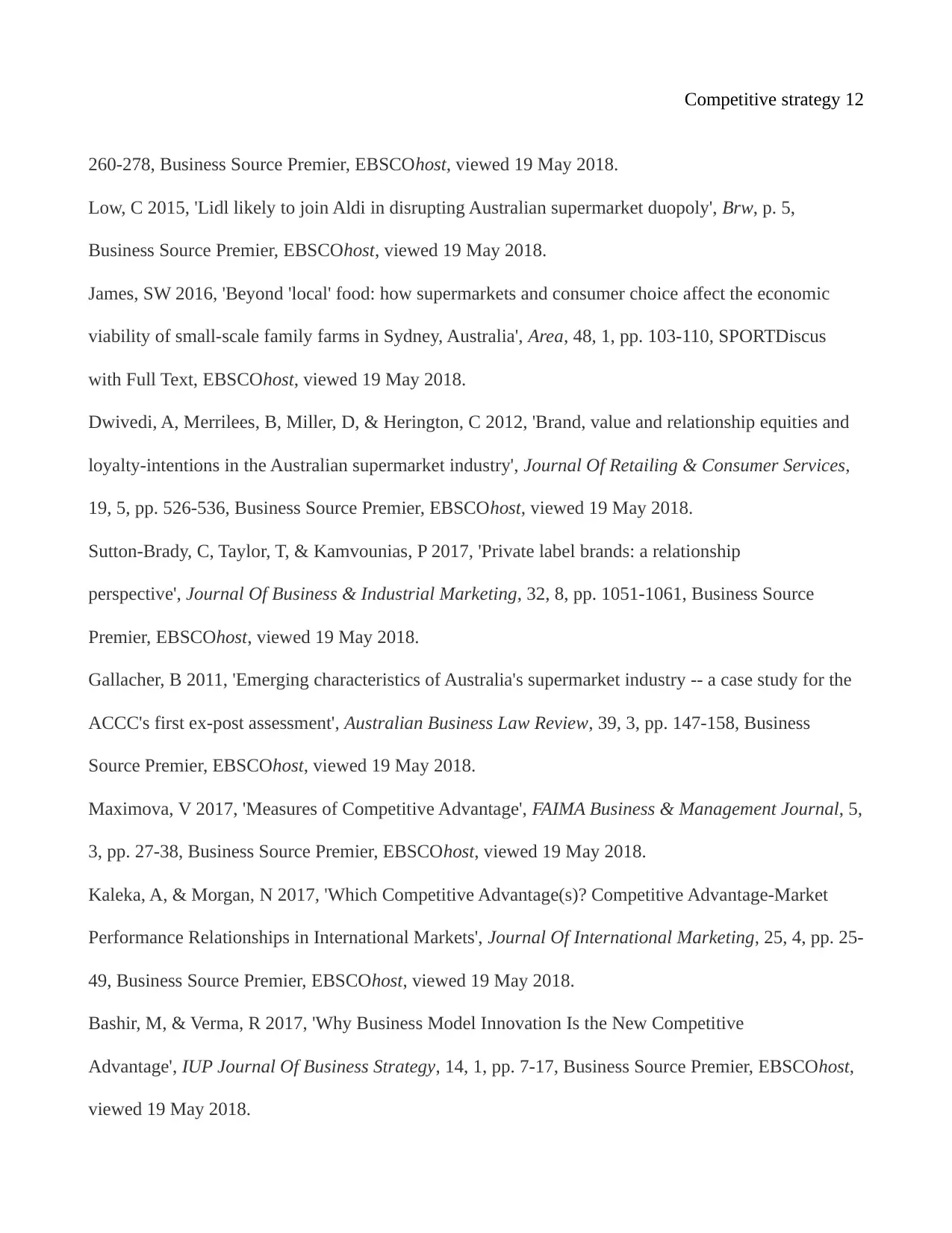
Competitive strategy 12
260-278, Business Source Premier, EBSCOhost, viewed 19 May 2018.
Low, C 2015, 'Lidl likely to join Aldi in disrupting Australian supermarket duopoly', Brw, p. 5,
Business Source Premier, EBSCOhost, viewed 19 May 2018.
James, SW 2016, 'Beyond 'local' food: how supermarkets and consumer choice affect the economic
viability of small-scale family farms in Sydney, Australia', Area, 48, 1, pp. 103-110, SPORTDiscus
with Full Text, EBSCOhost, viewed 19 May 2018.
Dwivedi, A, Merrilees, B, Miller, D, & Herington, C 2012, 'Brand, value and relationship equities and
loyalty-intentions in the Australian supermarket industry', Journal Of Retailing & Consumer Services,
19, 5, pp. 526-536, Business Source Premier, EBSCOhost, viewed 19 May 2018.
Sutton-Brady, C, Taylor, T, & Kamvounias, P 2017, 'Private label brands: a relationship
perspective', Journal Of Business & Industrial Marketing, 32, 8, pp. 1051-1061, Business Source
Premier, EBSCOhost, viewed 19 May 2018.
Gallacher, B 2011, 'Emerging characteristics of Australia's supermarket industry -- a case study for the
ACCC's first ex-post assessment', Australian Business Law Review, 39, 3, pp. 147-158, Business
Source Premier, EBSCOhost, viewed 19 May 2018.
Maximova, V 2017, 'Measures of Competitive Advantage', FAIMA Business & Management Journal, 5,
3, pp. 27-38, Business Source Premier, EBSCOhost, viewed 19 May 2018.
Kaleka, A, & Morgan, N 2017, 'Which Competitive Advantage(s)? Competitive Advantage-Market
Performance Relationships in International Markets', Journal Of International Marketing, 25, 4, pp. 25-
49, Business Source Premier, EBSCOhost, viewed 19 May 2018.
Bashir, M, & Verma, R 2017, 'Why Business Model Innovation Is the New Competitive
Advantage', IUP Journal Of Business Strategy, 14, 1, pp. 7-17, Business Source Premier, EBSCOhost,
viewed 19 May 2018.
260-278, Business Source Premier, EBSCOhost, viewed 19 May 2018.
Low, C 2015, 'Lidl likely to join Aldi in disrupting Australian supermarket duopoly', Brw, p. 5,
Business Source Premier, EBSCOhost, viewed 19 May 2018.
James, SW 2016, 'Beyond 'local' food: how supermarkets and consumer choice affect the economic
viability of small-scale family farms in Sydney, Australia', Area, 48, 1, pp. 103-110, SPORTDiscus
with Full Text, EBSCOhost, viewed 19 May 2018.
Dwivedi, A, Merrilees, B, Miller, D, & Herington, C 2012, 'Brand, value and relationship equities and
loyalty-intentions in the Australian supermarket industry', Journal Of Retailing & Consumer Services,
19, 5, pp. 526-536, Business Source Premier, EBSCOhost, viewed 19 May 2018.
Sutton-Brady, C, Taylor, T, & Kamvounias, P 2017, 'Private label brands: a relationship
perspective', Journal Of Business & Industrial Marketing, 32, 8, pp. 1051-1061, Business Source
Premier, EBSCOhost, viewed 19 May 2018.
Gallacher, B 2011, 'Emerging characteristics of Australia's supermarket industry -- a case study for the
ACCC's first ex-post assessment', Australian Business Law Review, 39, 3, pp. 147-158, Business
Source Premier, EBSCOhost, viewed 19 May 2018.
Maximova, V 2017, 'Measures of Competitive Advantage', FAIMA Business & Management Journal, 5,
3, pp. 27-38, Business Source Premier, EBSCOhost, viewed 19 May 2018.
Kaleka, A, & Morgan, N 2017, 'Which Competitive Advantage(s)? Competitive Advantage-Market
Performance Relationships in International Markets', Journal Of International Marketing, 25, 4, pp. 25-
49, Business Source Premier, EBSCOhost, viewed 19 May 2018.
Bashir, M, & Verma, R 2017, 'Why Business Model Innovation Is the New Competitive
Advantage', IUP Journal Of Business Strategy, 14, 1, pp. 7-17, Business Source Premier, EBSCOhost,
viewed 19 May 2018.
1 out of 12
Related Documents
Your All-in-One AI-Powered Toolkit for Academic Success.
+13062052269
info@desklib.com
Available 24*7 on WhatsApp / Email
![[object Object]](/_next/static/media/star-bottom.7253800d.svg)
Unlock your academic potential
© 2024 | Zucol Services PVT LTD | All rights reserved.




